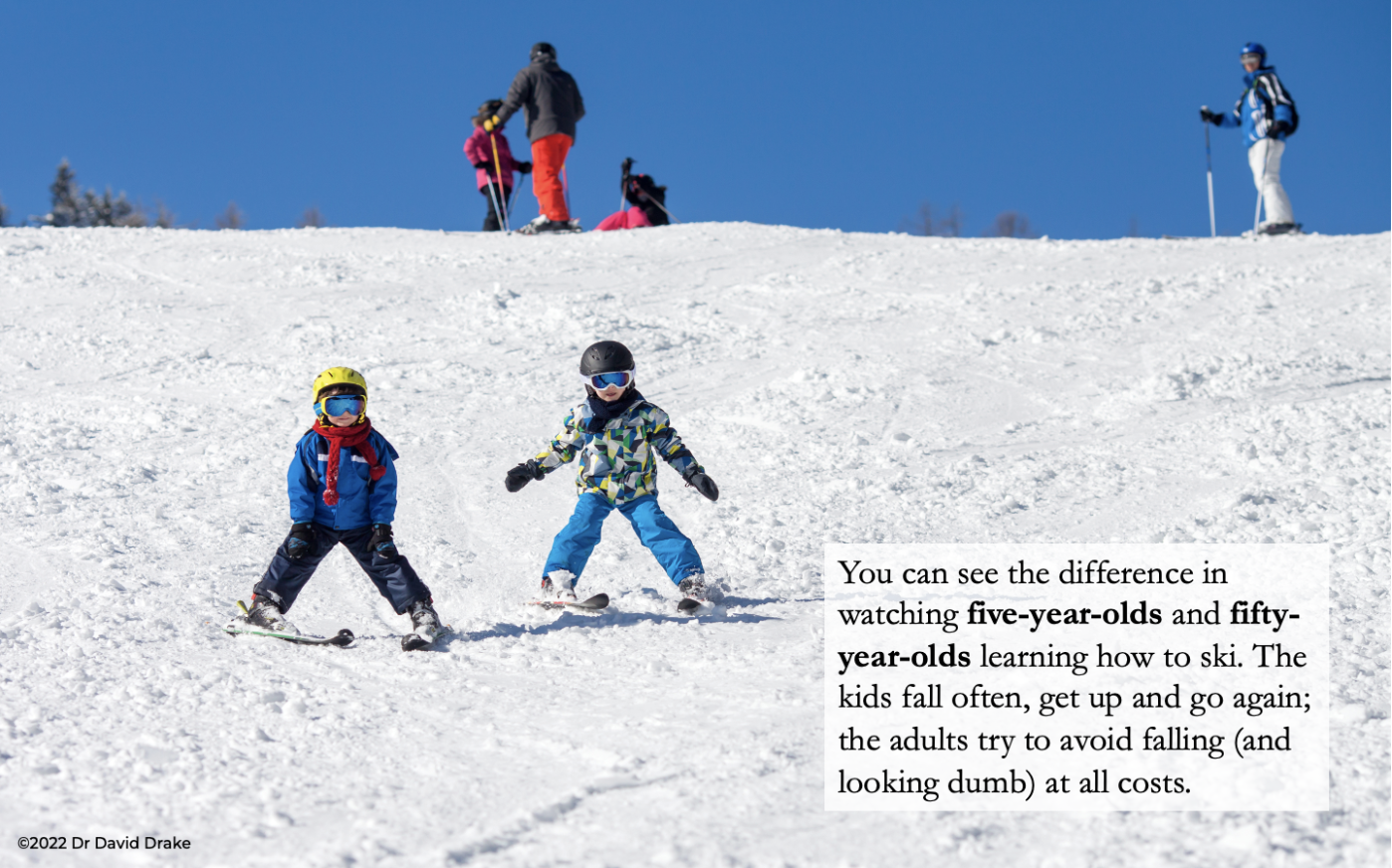
How Do We Actually Learn?
Traditional schools and training programs are based on the assumption that we can plan when, how, and what learning should occur for others. They use standard prescriptive methods and one-size-fits-all approaches that do not reflect how adults actually learn, let alone develop.
They’re problematic for many because most often when learning occurs it isn’t pre-planned. It rarely happens as we expect and often can’t be measured in the ways we predict.
However, despite the consistent evidence that these methods are not effective in delivering sustainable learning and performance outcomes, practitioners and buyers continue to use them because they are familiar.
If you’re going to help your clients address what matters most to them and their world, you need to move beyond these traditional beliefs about learning and development.
David kept saying to himself and audiences around the world, “There’s got to be a better way!” He wanted to create a process that reflected what he had unlearned after years of teaching in academia and training in organizations and what he had learned when he collaborated with clients to chart a new course (pun intended).
After a number of years of self-directed research and experimentation, he created Integrative Development. It provides the theoretical and applied foundation which enables practitioners to facilitate learning and development at any time with any person or group.
One of his major sources was pioneering child psychologists and educators, who offered a more natural approach that serves adults just as well.
The blog below will introduce you to this new approach. You’ll also discover:
- Why children often learn faster than adults (and what adults need to do differently)
- Why learning requires developmental threshold zones (and what adults are often missing)
- How to integrate serious play into your work (and why it is essential for adults)
Overall, you’ll gain a deeper understanding of how to support your clients as they approach and cross thresholds in their learning and development.
We’ll start with a note from Dr. David Drake:
Way back when I was in college, I was taking an elective to fulfill my General Education requirements. The topic was new to me and moderately interesting, but the professor did nothing but lecture us the entire time. He seemed annoyed when we asked questions. As the semester went on I sat farther in the back and eventually stopped coming all the time. I did, however, read the entire textbook and do all of the assignments.
I finished in the top 5% of the class in terms of my scores. Imagine my shock when I got my grade and found out he had given me a C. I stopped by his office to complain and asked for his rationale. He gave me an A for my achievements and an F for my (lack of) participation, which he averaged out somehow to be a C.
I asked him why I was being punished for the fact that he was not a good teacher. You can imagine how well that went . . . Hey, I was 20. I shared that I clearly demonstrated that I knew the material, and was not gaining anything from sitting through his classes that I could not do on my own. I did, in the end, appeal formally to the Dean and got the grade changed to a B.
This episode was an early inspiration for what became Integrative Development (ID) over time. Key to my ability to work this way was my own maturation, which is why we spend the first part of our ID Way Program focused on developing ourselves as practitioners. In many ways, this is largely about putting down assumptions and roles that don’t serve us or our clients well.
Help Them Re-learn How to Learn
Prior to attending school, children have not yet been socialized to the norm that they must first acquire knowledge about an experience before having the experience. Adults are often prone to self-consciousness and hesitation because they lack safe spaces to be and to practice.
That’s one of the reasons why children learn at a more rapid pace than the average adult. Adults can be deeply attached to the idea that they must first know before they can act.

The image above depicts this so well. The children in the bottom half of the frame are learning how to ski by skiing. They may fall. But with their helmets, short stature, and lack of performance metrics, falling does not hold the same consequences that it does for adults. While they may want to please their parents, their primary motivation is to have fun. The adults, on the other hand, are still at the top of the hill trying to look cool and talking to each other. They may be talking about techniques or learning from a coach, but they won’t become better skiers until they actually start skiing down the hill.
When we work with adults, our first task is often to get them out of their heads and back into their bodies and breath. Adults don’t need more information or explanations in order to change and grow, they need new experiences and the scaffolding to learn and grow from them. You can’t learn how to swim sitting by the side of the pool.
Help your clients realize that they will only benefit from their knowledge if they invest equally in their being and doing.
Recognize the Social Aspect of Learning
Most consulting and training approaches focus on clients as if they were separate entities. They fail to acknowledge that their identities and behaviors are an ongoing negotiation with social and contextual communal narratives and forces.
This is flawed because learning and development are socio-cultural processes. They are mediated through how they see themselves and others see them (identity) as well as their
relationships with others (past, present, and future).
This is why your relationship with a client is so important. If you can show up as a present, authentic, and responsive human being, the working relationship can act as a playground for your client’s growth.
Discover the Zone of Proximal Development
You’ve likely had the experience of being given a task that was so far beyond your current ability level that it filled you with anxiety or overwhelm. Alternatively, if a task is too far below your ability level, it will leave you feeling bored and unchallenged.
The tasks that are just slightly above your current ability level but that you can achieve with a little effort and support can be achieved in what child psychologist Lev Vygotsky called a zone of proximal development.
As we apply Vygotsky’s work to our work with adults, we recognize that the zone of proximal development is the ever-emergent and evolving distance between being and becoming.
David has built on Vygotsky’s work, his own research, and his work with Narrative Coaching to better understand the scaffolding adult clients need in order to grow.
Work With Developmental Threshold Zones
Developmental threshold zones include:
- How a client currently sees themself, their world, and their problem
- What is the crux of their issue and is it ready to be worked with?
- What scaffolding might the client need in order to step over this threshold?
- What experience is the client ready for as a step in this new direction?
- What has shifted as a result which can support the next step?
Developmental threshold zones are a structure in which clients have a safe space to experiment with new ways of being and doing. They’re at the heart of Integrative Development and how we work with clients to scaffold their becoming.
As clients cross each threshold, they not only increase their capability but also shift how they see themselves. Shifts in their identity provide a stronger foundation for them to enact what they have learned.
Developmental Threshold Zones & Serious Play
Crossing developmental threshold zones is how adult clients grow and evolve. In order to cross, however, clients must have the scaffolding they need and be willing to experiment with who and how they want to be and act in the world.
When clients aren’t ready, willing, and/or able to experiment, the potential for their learning and growth is diminished. Remember the picture of the children skiing from above. Your job is to help your clients re-learn how to learn, starting with a focus on their experience first and their performance second. Help them tap into their inner 5-year-old skier!
In ID, practitioners help make it safe for people to engage in what we have long-called serious play. A key to success is to invite them to focus on what they notice inside and outside themselves more than worrying about getting it right. That comes later. See your classes or your sessions as a playground where clients can try out new ways of being and doing.
Utilize Developmental Threshold Zones
Developmental threshold zones are at the center of our work inside The ID Way™ Program. They’re how we support meaningful and sustainable transformations with our personal and organizational clients.
You can learn how to utilize developmental threshold zones by joining The ID Way™ Program or tuning into the conversation happening inside The Threshold Lab.

